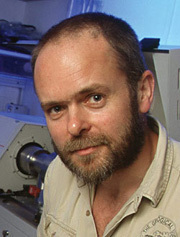
NASA announced Nov. 13 that its LCROSS lunar-impact probe mission found significant quantities of water in the plume of material the crash produced.
“We are ecstatic,” said Anthony Colaprete, project scientist for the LCROSS, a sentiment which is shared by Clive Neal, professor of civil engineering and geological sciences at the University of Notre Dame and a leading planetary geologist.
LCROSS, an empty stage rocket, crashed into the moon Oct. 9 while a small trailing satellite took chemical measurements of what was kicked up.
“The fact that they found water and other things in the spectra that they gathered shows us that we know less than we thought about our moon,” Neal said. “Combine these results with those of the Moon Mineralogy Mapper instrument results on the Indian Chnadryaan-1 that found water on the lunar surface outside of the permanently shadowed regions of the moon and we now have confirmation that sites that Apollo visited were not representative of the entire moon. It is like sending six landers to California and saying we now know everything there is to know about North America.”
Neal currently is in Houston for the annual meeting of the Lunar Exploration Analysis Group (LEAG), which will receive a briefing from Colaprete on the results of the LCROSS mission impact. Neal is chair of LEAG and also sits on the Planetary Science Subcommittee of the NASA Advisory Council.
A panel appointed by the Obama administration stated in October that NASA’s budget is not large enough for its current plan to fly astronauts to both the moon and, eventually, Mars. The administration is reviewing the panel’s recommendations, but Neal is clear on the direction in which he feels NASA should move.
“The LCROSS results also demonstrate that there are resources available on the moon that can support human return to the moon to establish a permanent habitat,” he said. “Just imagine if NASA had kept the focus on the moon after Apollo — where would we have been now?
“Right now, the only place we can safely send humans outside of low Earth orbit is the moon. NASA needs to stay the course this time and not flip-flop around the solar system. We need to go to the moon to learn to live and work successfully off-planet and then move on to Mars. It is an excellent way to stimulate private industry by involving the private sector in this endeavor.”
Neal also is a member of NASA’s recently formed Lunar Science Institute (LSI), which is a select team of scientists tasked with growing the nation’s technical capabilities in lunar science and developing educational opportunities in space science.
In addition to studying the origin and evolution of the moon, Neal also focuses on the geochemical and environmental consequences of plate interactions and petrogenesis of Large Igneous Provinces, as well as the environmental effects of heavy pollution.
Contact: Clive R. Neal, 574-631-8328, neal.1@nd.edu